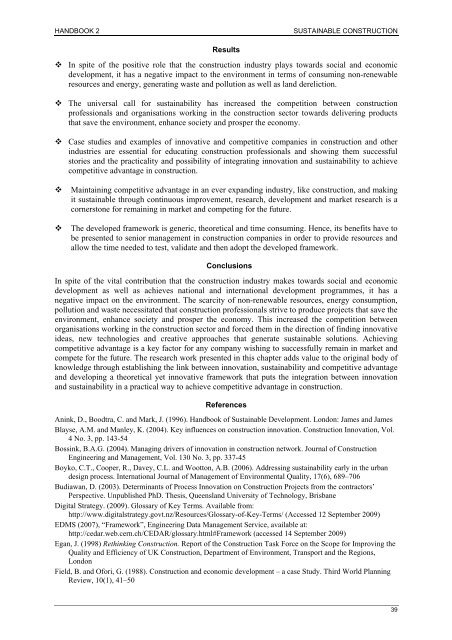Industrialised, Integrated, Intelligent sustainable Construction - I3con
Industrialised, Integrated, Intelligent sustainable Construction - I3con
Industrialised, Integrated, Intelligent sustainable Construction - I3con
Create successful ePaper yourself
Turn your PDF publications into a flip-book with our unique Google optimized e-Paper software.
HANDBOOK 2 SUSTAINABLE CONSTRUCTION<br />
Results<br />
� In spite of the positive role that the construction industry plays towards social and economic<br />
development, it has a negative impact to the environment in terms of consuming non-renewable<br />
resources and energy, generating waste and pollution as well as land dereliction.<br />
� The universal call for sustainability has increased the competition between construction<br />
professionals and organisations working in the construction sector towards delivering products<br />
that save the environment, enhance society and prosper the economy.<br />
� Case studies and examples of innovative and competitive companies in construction and other<br />
industries are essential for educating construction professionals and showing them successful<br />
stories and the practicality and possibility of integrating innovation and sustainability to achieve<br />
competitive advantage in construction.<br />
� Maintaining competitive advantage in an ever expanding industry, like construction, and making<br />
it <strong>sustainable</strong> through continuous improvement, research, development and market research is a<br />
cornerstone for remaining in market and competing for the future.<br />
� The developed framework is generic, theoretical and time consuming. Hence, its benefits have to<br />
be presented to senior management in construction companies in order to provide resources and<br />
allow the time needed to test, validate and then adopt the developed framework.<br />
Conclusions<br />
In spite of the vital contribution that the construction industry makes towards social and economic<br />
development as well as achieves national and international development programmes, it has a<br />
negative impact on the environment. The scarcity of non-renewable resources, energy consumption,<br />
pollution and waste necessitated that construction professionals strive to produce projects that save the<br />
environment, enhance society and prosper the economy. This increased the competition between<br />
organisations working in the construction sector and forced them in the direction of finding innovative<br />
ideas, new technologies and creative approaches that generate <strong>sustainable</strong> solutions. Achieving<br />
competitive advantage is a key factor for any company wishing to successfully remain in market and<br />
compete for the future. The research work presented in this chapter adds value to the original body of<br />
knowledge through establishing the link between innovation, sustainability and competitive advantage<br />
and developing a theoretical yet innovative framework that puts the integration between innovation<br />
and sustainability in a practical way to achieve competitive advantage in construction.<br />
References<br />
Anink, D., Boodtra, C. and Mark, J. (1996). Handbook of Sustainable Development. London: James and James<br />
Blayse, A.M. and Manley, K. (2004). Key influences on construction innovation. <strong>Construction</strong> Innovation, Vol.<br />
4 No. 3, pp. 143-54<br />
Bossink, B.A.G. (2004). Managing drivers of innovation in construction network. Journal of <strong>Construction</strong><br />
Engineering and Management, Vol. 130 No. 3, pp. 337-45<br />
Boyko, C.T., Cooper, R., Davey, C.L. and Wootton, A.B. (2006). Addressing sustainability early in the urban<br />
design process. International Journal of Management of Environmental Quality, 17(6), 689–706<br />
Budiawan, D. (2003). Determinants of Process Innovation on <strong>Construction</strong> Projects from the contractors’<br />
Perspective. Unpublished PhD. Thesis, Queensland University of Technology, Brisbane<br />
Digital Strategy. (2009). Glossary of Key Terms. Available from:<br />
http://www.digitalstrategy.govt.nz/Resources/Glossary-of-Key-Terms/ (Accessed 12 September 2009)<br />
EDMS (2007), “Framework”, Engineering Data Management Service, available at:<br />
http://cedar.web.cern.ch/CEDAR/glossary.html#Framework (accessed 14 September 2009)<br />
Egan, J. (1998) Rethinking <strong>Construction</strong>. Report of the <strong>Construction</strong> Task Force on the Scope for Improving the<br />
Quality and Efficiency of UK <strong>Construction</strong>, Department of Environment, Transport and the Regions,<br />
London<br />
Field, B. and Ofori, G. (1988). <strong>Construction</strong> and economic development – a case Study. Third World Planning<br />
Review, 10(1), 41–50<br />
39






